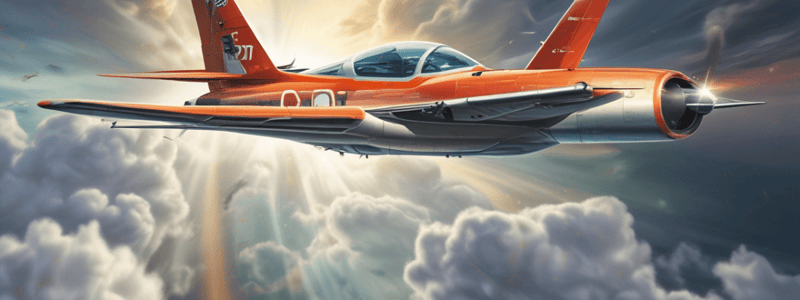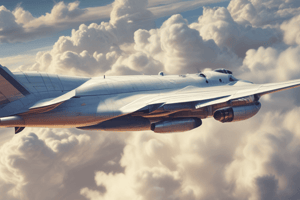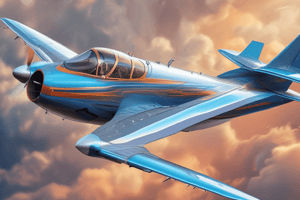Podcast
Questions and Answers
What is the primary benefit of a higher Rate of Climb (ROC)?
What is the primary benefit of a higher Rate of Climb (ROC)?
- A reduced engine power output
- An increased aircraft weight capacity
- A more efficient flight path and fuel savings (correct)
- A longer time to reach cruising altitude
What is a key factor in determining an aircraft's Rate of Climb (ROC)?
What is a key factor in determining an aircraft's Rate of Climb (ROC)?
- Number of passengers
- Wing shape
- Aircraft weight (correct)
- Aircraft length
How can pilots optimize climb performance?
How can pilots optimize climb performance?
- By flying at the recommended cruise speed
- By carefully managing weight and engine power (correct)
- By increasing the aircraft's airspeed
- By reducing the aircraft's altitude
What is the consequence of an aircraft being overweight during climb?
What is the consequence of an aircraft being overweight during climb?
Why is it essential to maintain the correct center of gravity (CG) during climb?
Why is it essential to maintain the correct center of gravity (CG) during climb?
What can affect engine performance and lift during climb?
What can affect engine performance and lift during climb?
What is the primary importance of understanding the factors that influence climb performance?
What is the primary importance of understanding the factors that influence climb performance?
What is the relationship between airspeed and climb efficiency?
What is the relationship between airspeed and climb efficiency?
What resource provides guidance on the best rate or angle of climb?
What resource provides guidance on the best rate or angle of climb?
What is the benefit of consulting performance charts specific to the aircraft and flying conditions?
What is the benefit of consulting performance charts specific to the aircraft and flying conditions?
A lower Rate of Climb (ROC) always indicates a more efficient flight path.
A lower Rate of Climb (ROC) always indicates a more efficient flight path.
Pilots can optimize climb performance solely by managing aircraft weight.
Pilots can optimize climb performance solely by managing aircraft weight.
The Aircraft Flight Manual (AFM) or Pilot's Operating Handbook (POH) provides guidance on the best rate or angle of climb, but not on aircraft loading and weight distribution.
The Aircraft Flight Manual (AFM) or Pilot's Operating Handbook (POH) provides guidance on the best rate or angle of climb, but not on aircraft loading and weight distribution.
Atmospheric conditions, such as temperature and pressure, have no impact on engine performance and lift during climb.
Atmospheric conditions, such as temperature and pressure, have no impact on engine performance and lift during climb.
Aircraft weight has no impact on the center of gravity (CG) during climb.
Aircraft weight has no impact on the center of gravity (CG) during climb.
Flying at the recommended climb speed has no significant effect on climb efficiency.
Flying at the recommended climb speed has no significant effect on climb efficiency.
Pilots should always prioritize engine power over aerodynamic efficiency during climb.
Pilots should always prioritize engine power over aerodynamic efficiency during climb.
Understanding the Rate of Climb (ROC) is more critical during cruise than during climb.
Understanding the Rate of Climb (ROC) is more critical during cruise than during climb.
The Rate of Climb (ROC) is directly proportional to the aircraft's aerodynamic efficiency.
The Rate of Climb (ROC) is directly proportional to the aircraft's aerodynamic efficiency.
A higher altitude always results in a higher Rate of Climb (ROC).
A higher altitude always results in a higher Rate of Climb (ROC).
During the climb phase of flight, what is the primary advantage of achieving a higher ROC?
During the climb phase of flight, what is the primary advantage of achieving a higher ROC?
What is the significance of consulting performance charts specific to the aircraft and the day's flying conditions?
What is the significance of consulting performance charts specific to the aircraft and the day's flying conditions?
How does adjusting the airspeed to the recommended climb speed impact climb efficiency?
How does adjusting the airspeed to the recommended climb speed impact climb efficiency?
What is the relationship between aircraft weight and climb gradient?
What is the relationship between aircraft weight and climb gradient?
Why is understanding the factors that influence climb performance crucial for safe and efficient flight operations?
Why is understanding the factors that influence climb performance crucial for safe and efficient flight operations?
How do changing atmospheric conditions impact engine performance and lift during climb?
How do changing atmospheric conditions impact engine performance and lift during climb?
What is the primary importance of maintaining the correct center of gravity (CG) during climb?
What is the primary importance of maintaining the correct center of gravity (CG) during climb?
How does engine power output impact climb performance?
How does engine power output impact climb performance?
What is the significance of the Aircraft Flight Manual (AFM) or Pilot's Operating Handbook (POH) in optimizing climb performance?
What is the significance of the Aircraft Flight Manual (AFM) or Pilot's Operating Handbook (POH) in optimizing climb performance?
Why is it essential to consider the aircraft's aerodynamic efficiency during climb?
Why is it essential to consider the aircraft's aerodynamic efficiency during climb?
Flashcards are hidden until you start studying
Study Notes
Thrust and Power in Climbs
- Thrust: the forward force produced by the aircraft's engines that propels it through the air, enabling the aircraft to overcome the forces of weight and drag during climbs
- Power: the rate at which work is done or energy is transformed, sustaining thrust over time and allowing the aircraft to maintain altitude during a climb
Thrust and Weight in Climbs
- As weight increases, the amount of thrust required to maintain a climb also rises
- Airspeed plays a crucial role in managing thrust and power, requiring pilots to find the optimal speed to balance lift and engine output
Thrust-to-Weight Ratio
- A critical metric that dictates how vigorously an aircraft can ascend into the firmament
- A high thrust-to-weight ratio means an aircraft can climb steeper and faster, which can be crucial in certain flight scenarios
Engine Performance at Higher Altitudes
- Engine performance might wane as the air becomes thinner, affecting power output
- Pilots must have profound knowledge and proficiency to manage engine settings and airspeed, ensuring that the climb isn't prematurely curtailed
Types of Climbs
- Maximum Angle of Climb (AOC): the steepest climb angle an aircraft can achieve, essential for clearing obstacles after takeoff
- Maximum Rate of Climb (ROC): the most efficient climb in terms of fuel consumption and time, focusing on gaining altitude quickly over time rather than distance
Calculating Climb Performance
- AOC: involves understanding the ratio of excess power to weight
- ROC: involves determining excess thrust available and relating it to weight
- Factors affecting calculations: weight, thrust, drag, and air density
Optimizing Climb Performance
- Managing weight: ensuring the aircraft is loaded within its allowable weight limits and the weight is appropriately distributed to maintain the correct center of gravity (CG)
- Ensuring proper engine maintenance for maximum power output
- Adjusting the climb speed to match the best rate or angle of climb as suggested by the Aircraft Flight Manual (AFM) or Pilot's Operating Handbook (POH)
Thrust and Power
- Thrust is the forward force produced by the aircraft's engines that propels it through the air.
- In the context of climbing, thrust is the force that enables the aircraft to overcome the forces of weight and drag, pushing it skyward.
- Power is the rate at which work is done or energy is transferred.
- Power is the stamina that sustains thrust over time, allowing the aircraft to not just reach, but also maintain altitude during a climb.
Thrust-to-Weight Ratio
- The thrust-to-weight ratio is a critical metric that dictates how vigorously the aircraft can ascend.
- A high thrust-to-weight ratio means the aircraft can climb steeper and faster.
Airspeed and Climb Performance
- Airspeed plays a strategic role in managing thrust and power during a climb.
- Finding the optimal airspeed is crucial to optimize the balance between lift and engine output.
- Too little or too much airspeed can adversely affect engine performance and aircraft handling.
Climb Performance Calculations
- Assessing climb performance often involves scrutinizing the thrust-to-weight ratio.
- The types of climbs, whether maximum angle or rate climbs, each demand their own specific power settings.
- Pilots must adapt and troubleshoot their flight path based on performance needs.
Maximum Angle of Climb (AOC)
- The Maximum Angle of Climb is the steepness of the climb path and is mainly used when clearing obstacles after takeoff.
- AOC is critical during departures from airports with significant obstacles in the takeoff flight path.
- Calculating AOC involves understanding the thrust-to-weight ratio, drag characteristics, and current atmospheric conditions.
Maximum Rate of Climb (ROC)
- The Maximum Rate of Climb is concerned with how quickly an aircraft can gain altitude, measured in feet per minute (fpm).
- ROC is significant during the climb to cruising altitude as it affects the overall efficiency of the flight.
- To calculate ROC, pilots must consider several performance factors, including aircraft weight, engine power available, atmospheric conditions, and the aircraft's aerodynamic efficiency.
Optimizing Climb Performance
- Pilots can optimize climb performance by carefully managing weight, ensuring proper maintenance of engines for maximum power output, and adjusting the climb speed to match the best rate or angle of climb.
- Understanding weight's impact on climb performance is crucial, as an overweight aircraft will have a reduced climb gradient and rate.
- Adjusting airspeed to the recommended climb speed can make significant differences in climb efficiency.
- Pilots must also be aware of changing atmospheric conditions such as temperature, pressure, and wind, which can affect engine performance and lift.
Thrust and Power in Climbs
- Thrust-to-weight ratio is critical in climbs, affecting the rate and angle of ascent
- High thrust-to-weight ratio enables steeper and faster climbs
- Engine performance may decrease at higher altitudes due to thinner air, affecting power output
- Pilots must adapt to changing performance needs, adjusting pitch, throttle, and sacrificing speed for altitude or vice versa
Climb Performance
- Climb performance is critical in aircraft operations, affecting fuel efficiency, safety, and timely arrivals
- Maximum Angle of Climb (AOC) and Maximum Rate of Climb (ROC) are key measurements
- AOC is the steepest climb angle an aircraft can achieve, important for clearing obstacles after takeoff
- ROC is the rate of gaining altitude, important for route efficiency and fuel conservation
Calculating Climb Performance
- AOC calculation involves understanding excess power to weight, air density, and engine performance
- ROC calculation involves understanding excess thrust, weight, and configuration, flap settings, and wind
- Variables affecting climb performance calculations include air density, aircraft weight, configuration, engine performance, and wind
Factors Affecting Climb Performance
- Air density, aircraft weight, and configuration, flap settings, engine performance, and wind affect climb performance
- Pilots must account for these factors when calculating AOC and ROC
Optimizing Climb Performance
- Pilots can optimize climb performance by managing weight, ensuring proper engine maintenance, and adjusting climb speed
- Understanding weight's impact on climb performance is crucial, as excessive weight reduces climb gradient and rate
- Adjusting airspeed to recommended climb speed can make significant differences in climb efficiency
Studying That Suits You
Use AI to generate personalized quizzes and flashcards to suit your learning preferences.




